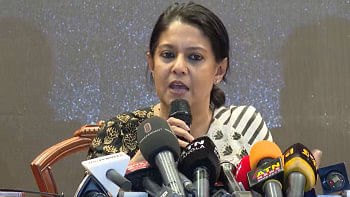Running the final mile

Bangladesh has endorsed elimination of poverty as a national goal, and the country can be proud of its achievements in this respect during the last 25 years. However, we cannot rest on our laurels because, even if the exact number of poor in Bangladesh is moot, it cannot be denied that we still have millions of people who live in poverty and suffer from the multiple scourges of poverty: hunger, malnutrition, and ill health.
Goal 1 of the Sustainable Development Goals (SDGs) is to eliminate extreme poverty by 2030. However, while we have embraced this goal, we face a formidable challenge. According to data available in Basic Statistics 2017 published by Asian Development Bank (ADB), 31.5 percent of our population live below the national poverty line in Bangladesh. If this statistic is correct, then more than 51 million people are currently poor. If we lower the bar and use the extreme poverty line of USD 1.25 per day as our yardstick, we still have almost 30 million people to serve. When our leaders proclaim that Bangladesh can eliminate poverty by 2030, can we take this seriously? Or is it just another example of electioneering?
As I see it there are two separate aspects of our SDG programme that we need to tackle: How do we monitor and evaluate poverty consistently over time given the myriad of thorny issues that measurement poses? And secondly, do we have the policies and programmes in place to eliminate extreme poverty?
On this note, I would like to focus on the inadequacies of our current policy package and programmes but want to add a few words on the need to refine the definition and strengthen the efforts for collection, analysis and interpretation of poverty data. As different countries around the globe join forces to eliminate poverty, we learn that there is more to poverty than simply income. Advanced research studies by Professors Bruce D Meyer of University of Chicago and James X Sullivan of Notre Dame have shown that, even in a formal economy, who is poor and who is not depends on how you measure. This sentiment is fortunately echoed in a recent Government of Bangladesh study Eradicating Poverty and Promoting Prosperity in a Changing World, Voluntary National Review (VNR), 2017. This self-study acknowledges the multidimensional nature of poverty and the need for a more comprehensive measure and additional investment necessary for "capacity building of its national statistical organisation for tracking the progress of SDG 1."
Turning to policy, Bangladesh has a much tougher task ahead compared to its South Asian neighbours. We need to focus more intently on policies to create the means, capacity, and opportunities for the poor to pull out of the "poverty trap". We are shooting for an eight percent GDP growth rate in the coming years, but even if we do succeed to grow faster than before, do we know that it will pull the poor out of the poverty trap? The evidence and research give us no reason to be too optimistic. Without being too pedantic, I want to mention some facts and analyses.
Jeffrey Sachs of Columbia University and Paul Collier of Oxford have strongly argued that poverty will not disappear of its own accord, especially in countries where it has been consistently high. Bangladesh appears to have relied heavily on job creation to pull the bottom half of the population out of poverty. While job creation is likely to help, it cannot by itself eliminate extreme poverty. "A change in circumstances (such as the end of conflict in Cambodia) or policies (such as China's household responsibility system) or a well-crafted intervention (such as Brazil's Bolsa Família cash transfer programme) is required to trigger a turning point in the quest to end poverty."
A recent publication by the Brookings Institution of the US—entitled How close is the world to ending extreme poverty?—gives us further reason to question our poverty elimination strategy. The study considered country-level trajectories for six key SDG targets: child mortality (under-5 and neonatal), maternal mortality, access to drinking water, access to sanitation, undernourishment, and primary school completion rates. Taking the first four of these targets, Bangladesh, along with Pakistan and Afghanistan, is unlikely to meet any of these targets by 2030!
So, the bottom line is while we can have a decent GDP growth, we run the risk of "jobless growth" too. Two recent accounts, one by Professor Selim Raihan of Dhaka University, and another by ADB, reveal an ominous trend. Using "employment elasticity" measure, Prof Raihan finds that two major South Asian countries, India and Bangladesh, experienced a substantial reduction in employment generation throughout the periods of high economic growth (2001–2015). While between 2001 and 2005, the annual average job creation in Bangladesh was 1.6 million, it declined to 1 million between 2011 and 2015. Against this background, ADB concludes that "even a growth rate of 7.4 percent (the average annual growth projected by the Planning Commission for the Seventh Plan period of 2015–2020) will not be adequate if the aim is to absorb all surplus labour in about 15 years. To achieve that goal, higher GDP growth will be required."
But we already saw that reliance on GDP growth will not do the trick. Transfers play a more important role for those farthest from the poverty line—the extreme poor. A multi-country study of Argentina, Brazil, Chile, Costa Rica, Colombia, Ecuador, Panama, Romania, and Thailand carried out at the World Bank reveals that transfers account for a greater share of the decline in the "poverty gap", the distance of the incomes of the poor to the poverty line, as well as in the decline of the "severity of poverty", a measure that gives higher weight to those farthest away from the poverty line. The study also shows that increases in cash transfers and pensions jointly account for a larger share of the decline in extreme poverty than changes in labour income. This finding is consistent with improvements those countries have made in the social protection systems, which are typically targeted to the bottom of the distribution, and which have increased in performance over the last decade.
It is well-known that extreme poverty is "sticky" i.e. the final effort to pull the last few millions out of poverty will demand extraordinary measures. Some have characterised this phase as the "final mile" analogous to the last mile in a marathon. So what do we need to do? Pull and push programmes have to work hand in hand, given that it is not a moral challenge but also an existential one. Elimination of poverty in Bangladesh is a top priority of the government and we need to get all "hands on the deck."
Dr Abdullah Shibli is an economist and works in the ICT industry.






Comments